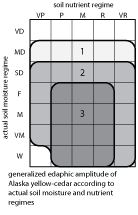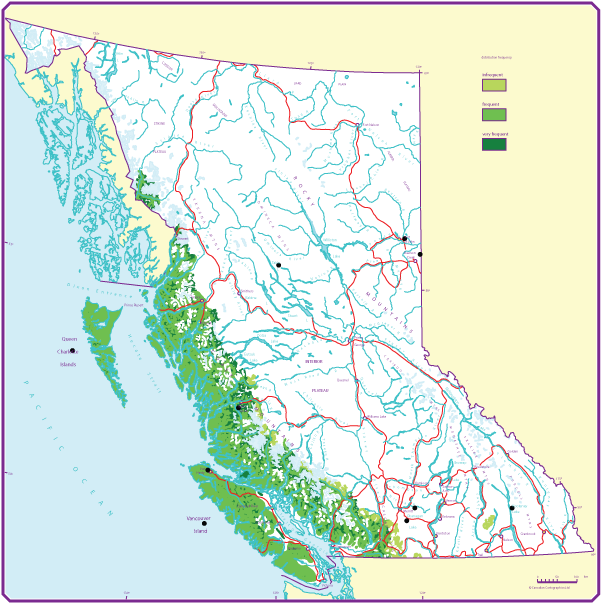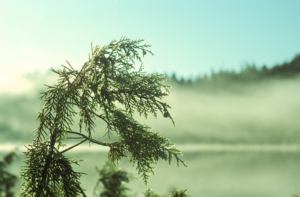Alaska yellow cedar
Alaska yellow cedar (Yc) - Chamaecyparis nootkatensis
A medium-sized (rarely >40m tall), evergreen, scale-leaved conifer, at maturity often with a slightly twisted (buttressed in old trees) stem, drooping leader, flattened, vertically hanging branches, and thin, grayish-brown bark that, with age, separates into narrow, intersecting ridges.
Alaska yellow cedar is a coastal, high-elevation, tree species. It is one of the slowest growing but most valuable conifers owing to the unique colour, texture, and durability of its wood.
On this page
- Geographic range and ecological amplitudes
- Tolerances and damaging agents
- Silvical characteristics
- Genetics and notes
Geographic range and ecological amplitudes
Geographic range
Geographic element:
Western North American/Pacific and less Cordilleran
Distribution in western North America:
north and central in the Pacific region; central (and south) in the Cordilleran region
Ecological amplitudes
Climatic amplitude:
subalpine boreal - cool temperate - cool mesothermal
Orographic amplitude:
submontane - montane - subalpine
Occurrence in biogeoclimatic zones:
MH, (ESSF), hypermaritime, upper, and northern CWH
Edaphic amplitude

Range of soil moisture regimes:
(moderately dry) - slightly dry - fresh - moist - very moist - wet
Range of soil nutrient regimes:
very poor - poor - medium - rich - very rich
The nutritional requirements of Alaska yellow cedar are comparable with those of western redcedar, even though Alaska yellow cedar is a little more tolerant of the soils derived from those igneous rocks in which calcium and magnesium rich minerals are almost lacking, but potassium feldspars are present. As in the case of western redcedar, nitrates are a better source of nitrogen for the growth of Alaska yellow cedar (Krajina 1969).
Tolerances and damaging agents
Root system characteristics
In freely drained soils Alaska yellow cedar develops a dense, profuse root system, with a non-existent or poorly defined taproot, similar to that of western redcedar. Fine roots form a very dense mat in the surface organic layer. Roots are mycorrhizal of the vesicular arbuscular type.
| Tolerance to | Tolerance class | Comments |
|---|---|---|
| Low light | H | As tolerant as Pacific silver fir. |
| Frost | L | Absent where the soil is not protected by snow from freezing. |
| Heat | L | Insolated sites are infrequent |
| Water deficit | M | Frequent on fragmental soils (talus). |
| Water surplus | H | Frequent on waterlogged sites. |
| Nutrient (mainly N) deficiency | H | Frequent on very poor sites |
| Damaging agent | Resistance class | Comments |
|---|---|---|
| Snow | M | Less resistant, more resilient; protection-requiring on high snowpack sites. |
| Wind | M | Less resistant on rock outcrops and waterlogged sites |
| Risk class | ||
|---|---|---|
| Fire | L | Not a serious and major concern in maritime wet (snowy) climates. |
| Insect | L | Not a serious and major concern in maritime wet (snowy) climates. |
| Fungi | L | Resistant to fungal attack. |
| Other agents | L | Reported dieback in southeastern Alaska, cause unknown. |
Associated tree species and successional role
In British Columbia, Alaska yellow cedar grows in uneven-aged, mixed-species stands, rarely in pure or even-aged stands. It is often a pioneer species on colluvial and wetland sites, and is present in early, mid-, and late stages of secondary succession; a major component in old-growth stands in the hypermaritime CWH subzones and MH zone.
| Associated tree species |
Occurance class | Major area of occurance |
|---|---|---|
| Mountain hemlock | H | One of the most common associates in MH. |
| Western hemlock | M | Hypermaritime and montane CWH. |
| Pacific silver fir | M | One of the common associates in MH and montane CWH. |
| Western redcedar | L | Hypermaritime and montane CWH. |
| Western white pine | L | Southern MH. |
| Sitka spruce | L | Northern hypermaritime MH and CWH. |
| Lodgepole pine | L | Mainly in hypermaritime CWH |
Genetics and notes
Genetics
Information on genetic variation of Alaska yellow cedar is not available; however, 15 horticultural varieties are recognized.
Notes
Interest in management of Alaska yellow cedar to assure its continuous supply is relatively recent, and information on growth and yield of second-growth stands is not yet available. However, it is a very promising species when considering its ecological, silvical, and timber values. More detailed silvics information is given by:
Harris, A.S. 1990. Chamaecyparis nootkatensis. Pp. 97-102 in R.M. Burns and B.H. Honkala (technical coordinators) Silvics of North America, Vol. 1. Agri. Handbook 654, USDA For. Serv., Washington, D.C.
Lousier, J.D. (compiler and editor) 1991. Yellow cypress: can we grow it? Can we sell it? FRDA Report 171, B.C. Min. For., Victoria, B.C. 57 pp.



